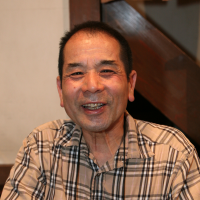
Yasuyuki Sakai
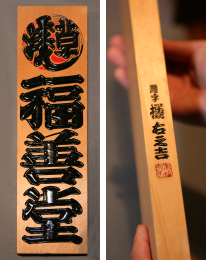
Left) Invitation signboard of "Fukuzen-do" that is Sakai's store name
Right) Inscription "Unokichi Tachibana"
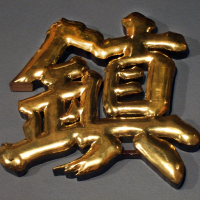
Chinese character plated with pure gold
What is signboard engraving?
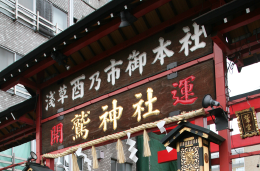
Oblong signboard of Otori Shrine in Asakusa, which was made by Sakai
What is the charm of signboard engraving?
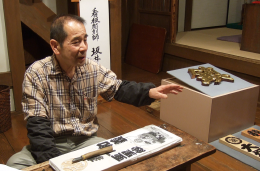
What is good about our work is that pieces of work will remain as objects in the future. On the other hand, however, I also feel anxiety because they will remain. Recently, customers who request me to engrave information, such as a birthday and body weight, on a gift "wooden tag" celebrating birth of a baby have been increasing. In 30 to 40 years, as the baby grows up, the tags will be filled with history and memories. I like to work with my hands while imagining a customer's happy face and deliver a product, with which the customer is purely delighted. That's the reason I continue to do this work.
As a signboard engraver
Could you tell me why you became a signboard engraver?
After all, I did not like a school, so I thought it would be better to be an apprentice after graduating from a junior high school at the age of 15. However, when young people are dependent on their parents, they tend to goof off, doesn't they? I played foul, and pretended to work hard. I think my parents knew that. So when my father (master) died, I was 19 years old and really perplexed because I could not do a job. Even though I knew how to do a job, it is not enough, isn't it? So I stayed up and worked all night. At that time, I had a lot of work to do.
I heard that your son, the fourth head-to-be, apprenticed himself to other master. Why did he do so?
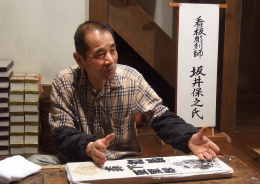
Production process: Part 1
Could you tell me about production processes?
From the first, production processes of signboards have been divided. There have been calligraphers, engravers and lacquerers. Nowadays, however, it is impossible make a living as a calligrapher, engraver or lacquerer. Moreover, characters can be easily made by computer. Most drafts that customers bring to me are data created by computer. So I sometimes lacquer signboards after engraving it though it is very rare. In the present, there is only one craftsman who specializes in lacquering signboards. If he died, signboard makers should lacquer signboards by themselves.
Do you sometimes design original characters?

Production process: Part 2
What kind of process are you doing now?
I paste an underlining of Japanese paper manufactured with a machine on a board cut out to the ordered size with seaweed glue. Then, I face it with pasteboard on which Chinese characters are written, and start to engrave it. I do all processes from preparations to finishing by hand. In the present, it is impossible to reduce the thickness of paper without using Japanese paper manufactured by a machine. Handmade paper is too elastic, so it sticks to a board when I remove it. I paste Japanese paper on a board with seaweed glue. If the Japanese paper is too elastic, I cannot remove it. On the contrary, if it is too weak, it is torn to pieces when I remove it, and I cannot complete the work beautifully. So it is difficult to adjust the amount of seaweed glue. In the past, craftsmen took a book bound in Japanese style apart, and used that Japanese paper.
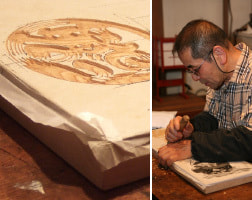
Engraving techniques
Could you tell me about engraving techniques?
"Kamaboko-bori (Gaku-bori)" is a technique to carve sumi characters in relief. Other main engraving techniques are "Ishiya-bori," in which characters are roundly carved as if a stonemason carved characters on a gravestone, "Jisuki," in which characters are flatly carved, "Tenkoku," in which three-dimensional characters are made by carving from surrounding portions, and "Yagen-bori," in which grooves of characters are carved in V-shape. Amateur engravers can do Tenkoku, but it is not easy for them to deeply carve characters.
Do you use different tools for different engraving techniques?
I do most carving processes with one chisel. All boards from large signboards to small wooden tags and characters on charms are basically carved with one chisel. I use a large chisel called "Sankaku-to" and a wooden hammer to engrave very large signboards.
What kind of difference is there between Tokyo and the Kansai Region?
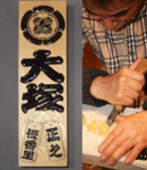
Pieces of work will remain as objects in the future
What do you think about the fact that signboards you created will remain as objects in the future?
I am happy that those signboards will remain as objects in the future. For example, if my sons or grandchildren can tell a signboard, which I or my father carved and delivered to a customer, when they visit the customer's place and see it by chance after some decades have passed, it is pretty good, isn't it? Speaking of a memorable piece that my father (master) left, there is a signboard, which was donated by several people living in Tokyo, at Hachiman shrine in Morioka City, Iwate Prefecture. When I visited the shrine by chance, I saw the signboard, thinking that it seemed to be a piece carved by my father, and found my father's name on it. When I counted backwards from the year, it turned out that it is a piece my father made right after he became independent. So when I see those actual pieces, I can recall my father. I sometimes considered my father's job performance while comparing my skill level and his. In this way, my father's job performance still remains as objects, and they will be handed to posterity. So I think signboard engraving is interesting. Signboards that I engraved with my spirit will remain as objects, and I can see scenes in which people use them. It is a joy and happiness when I am working.

Yasuyuki Sakai

Left) Invitation signboard of "Fukuzen-do" that is Sakai's store name
Right) Inscription "Unokichi Tachibana"

Chinese character plated with pure gold
What is signboard engraving?

Oblong signboard of Otori Shrine in Asakusa, which was made by Sakai
This kind of signboard is called "Hengaku," or oblong signboard, which originated in wooden name tags hung in front of courts and mausoleums in ancient China. The tags were introduced into Japanese palaces and Buddhist temples in the Asuka Period. In the Edo Period, the tags began to be used as a means for merchants and craftsmen to advertise store names and commodities, and many elaborate signboards were created.
What is the charm of signboard engraving?

What is good about our work is that pieces of work will remain as objects in the future. On the other hand, however, I also feel anxiety because they will remain. Recently, customers who request me to engrave information, such as a birthday and body weight, on a gift "wooden tag" celebrating birth of a baby have been increasing. In 30 to 40 years, as the baby grows up, the tags will be filled with history and memories. I like to work with my hands while imagining a customer's happy face and deliver a product, with which the customer is purely delighted. That's the reason I continue to do this work.






